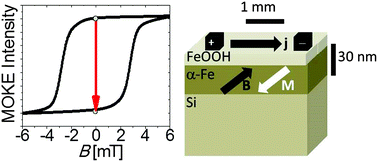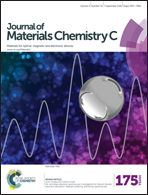Electrical switching of magnetization in a layer of α-Fe with a naturally hydroxidized surface†
Abstract
It is well established that electrical methods, such as the application of a high-density (1010–1011 A m−2) current, can be employed for the switching of magnetization in thin ferromagnetic films and heterostructures after their patterning at the nanoscale. We find that magnetization is robustly switchable, i.e., at macroscopic scales (up to a few millimeters in lateral directions), in a single ∼30 nm-thick layer of α-Fe upon discharging a capacitor through the sample. Interestingly, samples sputtered at enhanced base pressures (∼10−6 mbar) exhibited much lower switching thresholds with no bias field, while their electrical conductivity is anomalously high (higher than that in bulk of α-Fe). We argue that the observed enhancement of conduction relates to the mixed oxide/oxyhydroxide (FeO/FeOOH) layer formed naturally on the top of our α-Fe films. This provides an explanation for the magnetization switching upon discharging a capacitor in terms of the Oersted field generated by the discharge current. We analyze the ratio needed between the conductions of the FeO/FeOOH layer and the underlying α-Fe for the effective action of the Oersted field.


 Please wait while we load your content...
Please wait while we load your content...